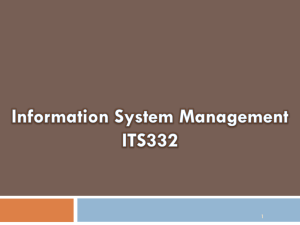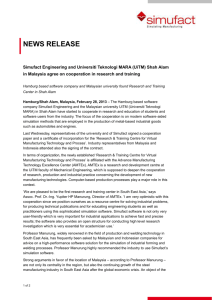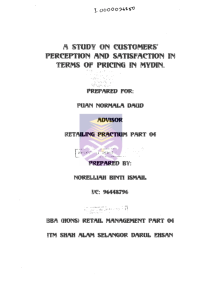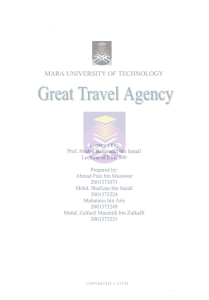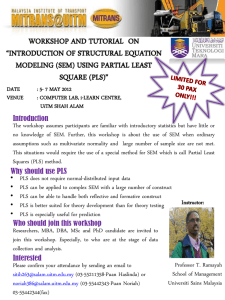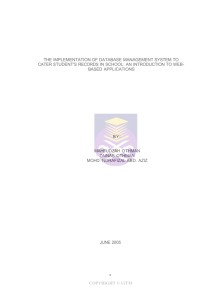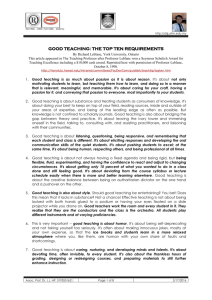ASSESSING THE TRAINING NEEDS OF ACADEMIC STAFF IN THE
advertisement
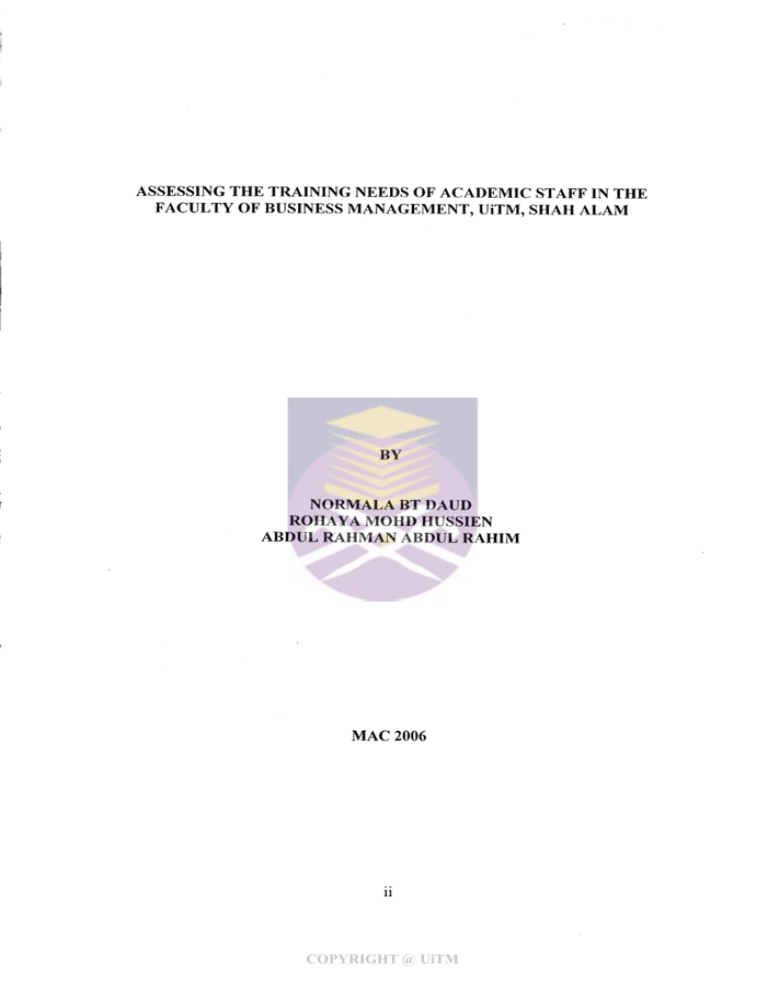
ASSESSING THE TRAINING NEEDS OF ACADEMIC STAFF IN THE
FACULTY OF BUSINESS MANAGEMENT, UiTM, SHAH ALAM
BY
NORMALA BT DAUD
ROHAYA MOHD HUSSIEN
ABDUL RAHMAN ABDUL RAHIM
MAC 2006
COPYRIGHT @ UiTM
@ uxrvERSIrI
ffi| TEKNOLOGI
ry \len;
40450, Shah Alam
Selangor Danrl Ehsan. N{alaysia
Rujukan
Tel
25 Februari 20O{
Tarikh
Fax
: 03 5-5.142000
:03 55442223
Prof. lladya l{ormala bt Daud
Pensyamh
Fakul$ Paqurusan kn&rgnan
Universi$ Tekndogl ltlARA
.f045O Shah Alanl
Puan,
PERITIOfDNAN GERAN PEI{YE1IDII(AIII.PROJEK'ASSESSII{G Tl{E TRAII{IilG
NEEDS OF ACADEPIS 5TAFF IN TI{E FACULTY OF BU5Iil6S }IJII{AGETIEI{T, UITIJI
SHAH Al/lltl'.
ker6 cadangran pan telah dinilai deh ahli-ahli lawabnkuasa
Penydktikan Fakulti Pergurusan Pemiagaan dan telah rrendapat pertimbangan dengan
keputsan -kepub-6an berikut: Sukacita dirnaldumkan bahawa
i.
ii.
Bersetuju mduluskan cadargan penydidikan yang dikemukakan oleh puan.
Tempoh projek penydidikan ini blah selama 12 bulan, iaitu mulai
l
ilac 2fit4 hingga
28 Februari 2005.
iii.
iv.
Kos yang dilutuskan ialah sebanyak RMl'O,Oqt,O{t (Ringgit }lalaysta Sepuluh Rihr)
puan sedia rnaklum, Fran perlu nnmbentangkan kertas kerja di
Selninar l-tasil Penydkiikan 'Irstihrte of Research, De\ie@fllent and C-omnercializatidl"
ORDCI setelah piojek ini tarnat djahnkan.
shaia. Sefrti )rilE
Panggunaan geran yang diluluslon hanya
alon diprose s€telah
perjanjian
ditardataqgani.
v.
Semua pembelian peralatan )€ng kcnya mdebihi RI',1500.00 satu item perlu
nrenggunakan Pesanan Jababn Universiti Tekndogi UnnA (LO). Pihak ruan iuga
dikehendaki rnernatuhi peratunn penerimaan penbtan. Sih rujuk kepada IRQC akan
perat.rran penerimaan peralatan baru dan penguncannya.
vi.
Kertas kerja bokfr dibentargkan di senSnar seHah 75o/o
dihantar
@af awal
laporan akhir Boiek
ke IRDC untuk semakan. Walau @aimanapun, prnn pedu
penrphonan kepada iRDC brlebih dahulu.
nl
COPYRIGHT @ UiTM
nnrnbuat
vii.
Pihak puan dikehendaki mengemukakan Laporan Kemajuan Projek Penyelidikan bagi
tempoh 6 bulan pertama penyelidikan d'rjalankan. Laporan Akhir perlu dihantar sebaik
sahaja projek penyelidikan disiapkan. Format menulis laporan akhir boleh diperolehi di
IRDC atau di Fakulti
Bersama-sama ini disertakan Perjanjian untuk ditandatangani oleh pihak puan. Sila penuhkan
perjanjian berkenaan dengan menggunakan pen berdakwat hitam dan kembalikan ke IRDC untuk
tindakan selanjutnya.
Sekian, terima kasih.
"SEI.AMAT MEN]AI.ANKAN PENYELIDIKAN"
Yang benar,
PROF. MADYA DR. JAMIL HJ. HAMALI
Dekan
Fakulti Pengurusan Perniagaan
s.k.
1.
Pegawai Kerja Akaun
Unit KewanganZon t7
Biro Penyelidikan dan Perundingan
UTM SHAH ALAM
2.
Puan Rohaya Mohd Hussein
Pensyarah
Fakulti Pengurusan Perniagaan
UiTM Shah Alam
3.
Encik AMul Rahman AMul Rahim
Pensyarah
Fakulti Pengurusan Perniagaan
UITM Shah Alam
4.
Prof. Madya Dr Rcmimah Mohd Roslin
Ketua Penyelidikan (Sains Sosial & Pengurusan)
Institute of Research, Development and Comrnercialization (IRDC)
UiTM Shah Alam
lv
COPYRIGHT @ UiTM
Tarikh:
No Fail Projek:
23 Mac 2006
600-IRDC/SSP.5/3/1012
Penolong Naib Canselor (Penyelidikan)
Institut Penyelidikan, Pembangunan dan Pengkomersilan (IRDC)
Universiti Teknologi MARA
40450 Shah Alam
Ybhg. Prof.,
'
LAPORAN AKHIR PENYELIDIKAN *ASSESSING THE TRAINING NEEDS OF
ACADEMIC STAFF IN THE FACULTY OF BUSINESS MANAGEMENT, UiTM,
SHAH ALAM.
Merujuk kepada perkara diatas, bersama-sama ini disertakan 3 (tiga) naskah Laporan
Akhir Penyelidikan bertajuk "Assessing the Training Needs of Academic Staff in the
Faculty of Business Management."
Sekian, terima kasih.
Yang benar
1^/ -**LJ-A-'I
t
vl/)
\
NdnualA BT DAUD
Ketua
Projek Penyelidikan
COPYRIGHT @ UiTM
PROJECT TEAM MEMBERS
ASSOCIATE PROFESSOR HAJAH NORMALA BT DAUD
Proiect Leader
"/l
r---
PUAN ROHAYA MOHD HUSSEIN
Project Member
ENCIK ABDUL RAHMAN ABDUL RAHIM
Project Member
.)
"lt/r'
7\a{r,:7./.!"o ?,-.^
vi
COPYRIGHT @ UiTM
ACKNOWLEDGEMENT
We would like to record our appreciation to all those people that has helped us in
completing this research.
Among them:
Associate Professor Dr Jamil Haji Hamali, dean of the Faculty of Business Management,
(until April 2005) and our present Dean of the faculty, Associate Professor Dr Zaini
Abdullah, and especially to Associate professor Dr Rokiah Hassan, who has initiated the
ideato capture the training needs of all the academic staff of the faculty.
Our appreciation also goes to all academic staff in the Faculty of Business Management
that has participated in this important survey.
Special thanks to Puan Mariam Khiri for her tireless help in typing the earlier draft of the
questionnaire. Thanks a Million Yam!
vlt
COPYRIGHT @ UiTM
TABLE OF CONTENTS
Page
Title Page
ii
Research Offer Letter
iii
Submission Report Letter
v
List of Team Members
vi
Acknowledgement
vii
Table of Contents
viii
List of Tables
xii
List of Figures
xiv
List of Appendices
XV
Abstract
xvi
CHAPTER
1 INTRODUCTION
1.1
Introduction
1.2
1.3 .
Background of the study
Problem Statement
1.4
ResearchObjectives
1.5
Research Questions
1.6
Scope of the Study
vlll
COPYRIGHT @ UiTM
1.1
Significance of the StudY
5
1.8
Definition of Terms
6
1.9
Organization of Remaining Chapters
6
CHAPTER
2
LITERATURE REVIEW
2.1
Introduction
2.2
The Importance of Performance
2.3
Training as a function in enhancing the performance of
academic staff
2.4
Training
2.4.1
2.5
-
What is successful training practices
The roles of individuals in training and development
11
12
ta
_lJ
Training Needs Assessment
2.5.1
i0
Training needs assessment's role
13
2.6
Training needs assessment techniques
l8
2.7
Training needs assessment Model
20
2.8
Competencies
22
2.9
Core competencies Perspective
25
2.9.1
Company-wide Perspective
25
2.9.2
Characteristics of the Individuals
26
2.9.3
Competency frameworks
26
2.9.4
Technology Competencies
27
2.9.5
Future CompetencY
28
2.10
Training is not always the solution
29
2.ll
Summary
30
IX
COPYRIGHT @ UiTM
CHAPTER
3
METHODOLOGY
3.I
Introduction
a1
3.2
Research Desisn
at
JI
3.3
Sampling Plan
3l
3.4
Population and Sample Size
aa
3.5
Design of Questionnaire
3L
3.6
Data Collection Procedure
34
3.7
StatisticalAnalysis
J.+
3.8
Summary
36
CHAPTER
4
JI
JZ
AA
RESULTS AND ANALYSIS OF DATA
4.1
Introduction
a-
4.2
Overview of data gathered
aa
3t
4.3
Respondents'Profile
38
4.4
DescriptiveStatistics
39
4.4.1
Current level of Technical Knowledge and Skills
40
4.4.2
Current level of Administrative Skills and Experience
4l
4.4.3
Current level of Management Skills and Experience
A')
1L
4.4.4
Current level of Personal development Skills
42
4.4.5
Current level of Knowledge in University and Faculty policy
and Procedures
43
Current level of Information Technolosy Skills
45
4.4.6
)t
4.5
Overall Ranking of Perceived Current Skills
46
4.6
Determining the Gaps in Training Needs Assessment
47
4.7
Ranking of Important Skills Needed
49
COPYRIGHT @ UiTM
4.8
54
Summary
CHAPTER
5
DISCUSSION AND CONCLUSION
))
5.1 Introduction
5.2
Discussion on
Findingt
55
skill
57
5.2.1
Current Competency level in Technical knowledge and
5.2.2
Current Competency level in Administrative
5.2.3
Current Competency level in Management skill and
experience
5.2.4
Current Competency level in Personal Development
skill
58
5.2.5
Current Competency level in Knowledge in University and
Faculty Policy and Procedures
s9
Current Competency level in Information Technology skill
59
5.2.6
skill
58
58
5.3
Overall Perceived Cunent Skill
60
5.4
Gaps Pertaining to Skill Importance
60
5.5
Implications of the Study
61
5.6
Limitation of the Studv
62
5.1
Conclusion
62
5.8
Recommendations
63
67
REFERENCES
APPENDICES
DURATION OF RESEARCH
XI
COPYRIGHT @ UiTM
LIST OF TABLE
No.
Title of Table
Page
Table 2.1
Approaches Determining Training Needs
21
Table 4.7
Characteristics of Respondents
39
Table 4.2
Mean and Standard Deviation of Current level of
Technical Knowledge and Skills
4l
Table
Table 4.3
Mean and Standard Deviation of Current level of Administrative
Skills
42
Table 4.4
A'
Mean and Standard Deviation of Current level Management Skills +)
Table 4.5
Mean and Standard Deviation of Current level of Personal
Development Skills
Table 4.6
Mean and Standard Deviation of Current level of Knowledge
in University & Faculty Policy and Procedures
15
Mean and Standard Deviation of Current level of Information
Technology Skills
46
Table 4.8
Overall Ranking of Highest Perceived Current Skill
+t
Table 4.9
Level of Lowest Perceived Current Skill
AT
Table 4.10
Technical Knowledge and Skill: Mean, Standard Deviation and
Gap Analysis
Table 4.11
Administrative Skill: Mean. Standard Deviation and Gap
Analysis
51
Management Skill: Mean, Standard Deviation and Gap Analysis
51
Table 4.7
Table 4.12
xll
COPYRIGHT @ UiTM
Table 4.13
Personal Development Skill: Mean, Standard Deviation and Gap
Analysis
Table 4.14
University & Faculty Policy and Procedures: Mean,
Standard Deviation and Gap Analysis
Table 4.15
Information technology Skill: Mean, Standard Deviation and
Gap Analysis
53
Ranking of Important Skills Needed based on Perceived Gap
54
Table 4.16
xlll
COPYRIGHT @ UiTM
52
53
LIST OF FIGURES
Figure
No.
Title of Figure
Page
Figure
2.1
The Training Process
t4
xiv
COPYRIGHT @ UiTM
LIST OF APPENDICES
Appendix
No.
Title of Appendix
Appendix
A
Sample Cover letter and Questionnaire
Appendix
B
Respondents Characteristics
Appendix
C
Mean and Standard Deviation of Technical Knowledge
and Skill
Appendix
D
Mean and Standard Deviation of Administrative Skill
Appendix
E
Mean and Standard Deviation of Management Skill and
Experience
Appendix
F
Mean and Standard Deviation of Personal development
skill
Appendix
G
Mean and Standard Deviation of University & Faculty
Policy and Procedures
Appendix
H
Mean and Standard Deviation of Information Technology
skill
COPYRIGHT @ UiTM
ABSTRACT
The fields of training and development has undergone changes that reflect the dynamic
factors in the corporate world overall. Staff training is crucial and challenging task that
has come to be identified with the determination
of the future of many organizations.
Without relevant and appropriate training, employees may fail to perform at the level
expected
of them in achieving the stated goals of the organization. Training needs
assessment
is posited as one of the fundamental requisites of an effective
program. The purpose of this study is to
assess the
training
training needs of all academic staff in
the Faculty of Business Management. Questionnaire was developed and distributed to all
the fulltime academic staff in the faculty. A total of 20 useable responses were obtained
and used for the purpose of data analysis. The findings of this study discovered the
existence
of gaps in terms of the competencies among various academic staff.
Based
upon the study findings, practical implications are discussed. Limitation of the study and
suggestions for management actions are also discussed.
xvr
COPYRIGHT @ UiTM
CHAPTER
1
INTRODUCTION
I.l
Introduction
This chapter describes a briefbackground ofthe research. It explores the problem
statement, objectives of the study, research questions, scope of the study and finally the
significance of and outline of the reporl-
1.2
Background of the StudY
Throughout our lives learning experiences are a potent source of stimulation' As
our society advances economically and technologically, the need for effective job
performance becomes
very critical, not only in achieving increased levels of
organizational efficiency, but also to achieve higher levels
of self-satisfaction for
the
individuals, not forgetting gaining their commitment and loyalty. In addition, the impact
of globalisation has created many challenges in fulfilling these desires. Globalisation has
opened many doors. The new economic situation is no more driven by industries and
mass production; instead
as the new market
it is being influenced by information. Information is regarded
commodity. This shift has brought in a new type of product that
is
creativity and innovation in information and communication technology (ICT). Within
this lies equal footing with other developed countries.
COPYRIGHT @ UiTM
Plan, has come out
Consistent with these needs' Malaysia in its Eighth Malaysian
and developing the
with the Human Resource Poiicy Thrusts that focuses in creating
following:
i)
Expanding the supply
of highly skilled and knowledge manpower
to
support the development of knowledge-based economy'
ii)
Increasing the accessibility to quality education and training to enhance
the incoming generation's capabilities and quality of life'
iii)
Improving the quality of education and training delivery system to ensure
sufficient manpower supply that is in line with technological change and
market demands.
i,r)
Promoting life-long learning
v)
Increasing the supply of science and technological manpower.
vi)
Developing Malaysia into a regional center of educational excellence.
vii)
Reinforcing positive values'
The most essential resource to meet these desires
will solely depend on the human
component. This human component need to be developed and shaped into competent
workforces that are able to self-managed themselves and are able to use their skills and
expertise to achieve their full potential and to contribute their best to the organization and
to the country as a whole. This is where UiTM will play its role, specifically the Faculty
of Business Management.
The transformation of ITM to UiTM has opened many doors, one being the main
supplier of future generation workforce competent with ICT
skills. To produce
these
workforces, UiTM in general and the Faculty of Business and Management in particular
COPYRIGHT @ UiTM
will
have
to come out with an integrative'
continuous and systematic process of
especially the academicians who are
enhancing their human capabilities and capacities
The academicians are
very directly linked to these future workforces to be developed'
society equipped
the main key persons who are responsible to create a knowledge-based
with ICT skills that will turn out to be our future generation workforce'
1.3
Problem Statement
As many ol us are aware, the primary component to meet the demand of today's
challenges
will be the human component. The human component that this study will
be
in
interested in is the academic staff that makes up the Faculty of Business Management
UiTM
Shah
Alam. The
questions that intrigued the researchers most are:
Are the academic staff utilizing their utmost potentials?
Are they being properly developed or groomed into individuals who
are
highly skilled in their field of expertise?
Are the academic staff of the Faculty of Business Management equipped
enough with the appropriate knowledge, skills and abilities to produce the
workforce the country demands?
Is there an appropriate career development structure or system established
to mould and developed these academic staff?
Is there any systematic competency inventory database (iob descriptions)
of the staff?
These are the questions that have given rise to the researchers' interest
in doing
this research. The research aims at assessing the current situation of the academic staff
with
regards
to their skills, kno'wledge, and abilities to perform their role as lecturers
COPYRIGHT @ UiTM
academic staff with the required
effectively and efficiently, and thus, creating a pool of
and much needed competencY level'
1.4
Research Objectives
Specifically, the objectives of this research are:
1)
staff'
To identify and assess the current competency level of academic
2)
To identify and examine the extent of the competency gap amongst academic
staff.
3) To identify the future training needs of academic
4)
T-o recommend strategic actions
staff.
to be taken by the management of the faculty to
maximize the academic staff potential'
1.5
Resesrch Questions
Based on the research objectives above, the research questions
ofthis study are as
follows:
1.6
l)
What is the current competency level of academic staff?
2)
What is the extent of the competency gap amongst the academic staff?
3)
What are the future training needs of academic staffl
Scope of the Study
This study concentrates on all the full-time academic staff of Faculty of Business
Management, in Shah Alam only. This study will not include contract lecturers and other
part-time lecturers.
COPYRIGHT @ UiTM
1.7
Significance of the Study
This project and its findings are considered important to several groups:
1.
The Nation
The study is able to generate a knowledge society that practices academrc
freedom, which are adaptable and innovative, possess intellectual integrity
and practices ethical standards.
2.
The Organizatron (UiTMy The faculty
To sustain, transmit and develop an understanding of knowledge.
To inculcate learning values in which each staff member will be clear
about our shared values and mission thus creating a learning organization
that practices high performance culture.
To develop leadership skills at all levels as well as obtaining continuing
loyalty and commitment and retaining outstanding staff through
the
mechanisms of high quality development programs.
3.
The Individual (Lecturers)
The study will generate academic members who are:
Committed to producing quality graduates
Committed to improve in research performance
committed to enhanced their teaching and leaming skills
and
knowledge
committed to resourcing and managing
COPYRIGHT @ UiTM
a
world-class university.
1.8
DeJinition of Terms
l-8.1
Training Needs Assessmenl. A systematic process to determine whether or
not the training should be held, who needs training and what kind of training should be
held.
1.8.2 Training. The
process
of providing employees with specific skills or
helping them to correct deficiencies in their performance (Fitzgerald, 1gg2).
1.8.3
Succession
preparing people to
L8.4
fill
Planning. A career development is an activity that focuses on
executive position.
Career Development. An ongoing and formalized effort that focuses on
developing enriched and more capable workers. (Gomez-Mejia, Balkin
1.8.5
Competency
Gap. The current
& Cardy,2A0q.
competency level minus the expected
competency level of academic staff.
1.9
Orgonization of Remaining Chapters
This report is divided into five chapters. The first chapter provides with
an
overview of the background of the study, the problem statement, objectives of the study,
research questions, significance of the study, and lastly, scope of the
study. Chaprer two
reviews the concept of training, competency and the literature on training needs analysis.
Chapter three describes the research methodology and design employed in gathering and
analyzing the data. Chapter four reports the findings of the study. The profiles of the
respondent, descriptive statistics and the gap analysis are presented. Chapter five
presents the discussion and recapitulation of the whole study, provides interpretation and
conclusions related to the research objectives, and discusses the implications of these
results for future research.
COPYRIGHT @ UiTM
CHAPTER
2
LITERATURE REVIBW
2.1
Introduction
This chapter is devoted to the literature on training needs assessment (TNA). This
chapter begins with a review on the importance of performance, the concept of training,
various training needs assessment techniques and training needs assessment model and
competencies.
2.2
The Importance of Pedormance
Why should employees care about performance? Is training the answer to human
resource accumulation and performance enhancement?
An organization that wants to be successful must continuously strive to improve its
performance regardless whether they are business or academic based. A variety of social
and economic reasons have forced organization
to
analyze their current and future
performance requirements so that they may remain competitive
in the marketplace.
Some of these pressures include: increased global competition, company restructuring,
decline of the manufacturing sector, continuous technological change, changes in the
growth and the composition of the workforce. Hendry and Pettigrew (1995), Bartlett and
Goshal (1995), for example, argue that given the nature
of the external
environment
which many firms now find themselves operating in, there is a peculiar shift away from a
COPYRIGHT @ UiTM
knowledge and learning as a key stlateglc
focus on physical capital to one of managing
based era' the scarce strategic resource
focus. They further argue that "in a knowledge
is the qualit'v of the people
that will allow one company to surpass its competitors
working for it...'.-"
through the role
One answer to these situations is human resource accumulation
played
by human resoulce
development (HRD). Discussion
accumulation has occurred frequently
on human
capital
in many recent literatures as a key outcome of
human resource development. A number of influential models of HRD practices which,
if pursued are likely to contribute to human capital accumulation
and development.
These models basically advocate for investment to be emphasized on developing human
resources by organizations and individuals. This gesture is to meet several purposes, and
they are to build and to maintain that resource in the future and to retain that resource in
the present. Pricket (1998) reports that the London Univesity's survey of graduates found
that over 90 percent expect their employer to help their development. Holbeche (1998),
on the other hand, found that one third of her sample of high-fliers would leave their
employment
perceived
if they could not broaden their skills. These studies reveal that individuals
the investments that the organization's make in their human
capital
performance enhancement to be very valuable.
Developing their human resource has also become the main focus on many
organizations
lately. Losey (1999) and Spandenberg et al. (1999), among others report
that increasingly organizations, seek through the implementation of sophisticated human
resource development and workplace learning, strategies
to
develop employee
competencies to enable them to respond quickly and flexibility to business needs. This
COPYRIGHT @ UiTM
stressed that developing human resource competencies are
vital for HRD success' The
origin of the notion of human capital can be attributed to the work of Prahalad and Hamel
(1990) that analyzed the competitiveness of organizations and attributed
possession
it to the
of core competencies. Capelli and Singh (1992) argue that competent
employees potentially create sustainable competitive advantage where such competencies
are organization specific and are
difficult to imitate.
Both parties, either from the perspective of the organization or the individuals,
with regards to achieving human capital point to four key attributes of human resource as
capital:
enhancement
of
individual competencies (Athey
Sparrow, 1992), the development
of
&
Orth, 1999; Boam &
organizational competencies (Atkinson, 1984;
Blyton & Morris, 1991; Capelli & Crocker-Hefter, I996; Gorsline, 1996; Holms, 1995:
Lei & Hit, 1996), flexibility and adaptability (Waterman et al., lgg4) and individual
employability (Arthur and Rousseau, 1996; Bates
emphasis that organization
& Bloch, 1995; Ellig, 1996).
will put on these four factors will
generate
The
a range of
additional positive individual and organizational outcomes. The more frequently cited
ones include higher performance (Sandberg, 2000); high quality individual
and
organizational problem solving (Schroder, 19S9); enhanced career plans and increased
chances
of
securing full+ime employment
sustainable competitive advantage (Winterlon
(weick, 1996; Raider & Burt,
& Winterton,
1996; Nordhoug,
1996);
l99g);
and
higher organizational commitment (lles et al., 1990); and enhanced organizarjonal
retention (Robertson et al.. 1991).
From what that has been reviewed above, the faculty of Business Managemept
of
UiTM rvould consider the
issues
of holv to improve its current competency level of its
COPYRIGHT @ UiTM

